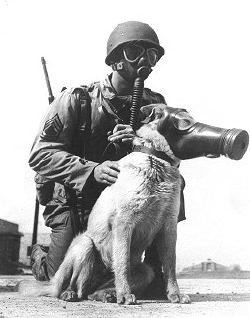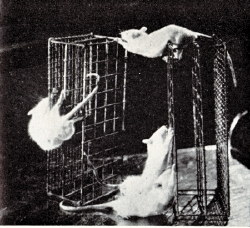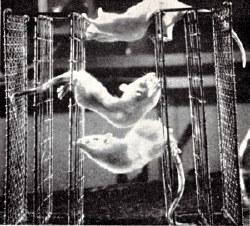Animals
Fish Removed From Bladder

An interesting case study is reported in the Internet Journal of Urology (2007, Vol. 4, #2). It's titled "Unusual Foreign Body In Urinary Bladder: A Case Report."
A 14-year-old Indian boy showed up at a hospital complaining of pain and difficulty urinating. He claimed that a fish had lodged itself in his penis. His story, according to the doctors:
Sure enough, he DID have a dead fish in his bladder. Initial attempts to remove it with a biopsy forceps were unsuccessful. The fish was too slippery to grasp onto. But with the help of a rigid ureteroscope they got it out.
The doctors seem a little skeptical of the boy's story. They note that, "Introduction into the bladder may be through self-insertion, iatrogenic means or migration from adjacent organs."
Posted By: Alex - Thu Aug 28, 2008 -
Comments (5)
Category: Animals, Medicine
Wild Women of Wongo

You'll have to decide for yourself. First, take a look at the unfortunately bleached-out trailer. Then view the whole film--in glorious "Pathecolor"--on YouTube, in several parts, with the first one featured after the trailer.
Also on YouTube is the MST3K version.
Posted By: Paul - Tue Aug 26, 2008 -
Comments (6)
Category: Animals, Domestic, Marriage, Family, Hollywood, Movies, Gender, Men, Women, Foreign Customs, 1950s, Dance
The South Will Collect Its Pensions Again!
Posted By: Paul - Mon Aug 25, 2008 -
Comments (3)
Category: Animals, Death, Obituaries, History, Historical Figure, Hollywood, Literature, Books, Regionalism, War, Cartoons, Marriage
The Birds
A year ago, when I read this article about a local couple whose house was besieged and befouled by vultures, I just shrugged it off.But now, encountering fresh news about a horde of filthy egrets, I realize that everything Alfred Hitchcock tried to warn us about is coming true!
Posted By: Paul - Sat Aug 23, 2008 -
Comments (4)
Category: Animals, Hygiene, Excrement, Movies, War
Worst. Crackers. Ever!

Posted By: Paul - Thu Aug 21, 2008 -
Comments (20)
Category: Animals, Business, Products, Food, Inventions, Stupidity, 1960s
Dog Gas Masks

Posted By: Alex - Wed Aug 20, 2008 -
Comments (0)
Category: Animals, Inventions, Military
Catatonic Rats
Old science books and articles are a great source of weird images. For instance, I found the two pictures below in Of Mice, Men and Molecules by John Heller (published in 1960). The images are titled "Catatonic rats" and have this explanatory caption:Unfortunately, Heller doesn't reveal what the chemical is that caused the rats to freeze in these positions. My guess is that it's LSD.
 |  |
Posted By: Alex - Mon Aug 18, 2008 -
Comments (3)
Category: Animals, Drugs, Science, Experiments
Follies of the Mad Men #12
Yes, I want my beer to be endorsed by a drunken chipmunk who's been taking fashion lessons from Andy Capp.Amazingly, despite this appalling choice of spokes-mammal, Stegmaier Beer remains in business to this day, as you can see if you follow the link.
Any reader ever tasted a "Steg"?
Posted By: Paul - Thu Aug 14, 2008 -
Comments (5)
Category: Animals, Business, Advertising, Products, Inebriation and Intoxicants, Regionalism, Comics
Real Horse That Looks Like Stuffed Toy
Here at WU Central, the proprietors believe in training up the next generation to be observant and appreciative of all things weird. Hence the photo you see here.This image was taken by my tweener niece, Becky Fuller, at the farm my brother Frank and his wife Beverly own in Medford, Oregon. It depicts a curious beast Becky calls "the curly horse."
Becky is enrolled in 4-H, and they've plainly been conducting secret experiments to hybridize sheep and horses. How else to explain the odd woolly fur of this anomalous quadruped, its mullet-like mane, or the unnaturally symmetrical appearance of its brown "stockings"?
Be afraid--be very afraid!
Posted By: Paul - Thu Aug 14, 2008 -
Comments (6)
Category: Agriculture, Animals, Domestic, Family, Photography and Photographers
Stop massaging that horse!
Maryland-resident Mercedes Clemens has been forced to shutter her horse massage business. Although she's certified to massage humans, she's not certified to massage animals. According to the Associated Press:In other news, THERE ARE ANIMAL MASSAGE REGULATIONS!
(Thanks, Big Gary!)
Posted By: Alex - Tue Aug 12, 2008 -
Comments (3)
Category: Animals, Regulations

| Who We Are |
|---|
| Alex Boese Alex is the creator and curator of the Museum of Hoaxes. He's also the author of various weird, non-fiction, science-themed books such as Elephants on Acid and Psychedelic Apes. Paul Di Filippo Paul has been paid to put weird ideas into fictional form for over thirty years, in his career as a noted science fiction writer. He has recently begun blogging on many curious topics with three fellow writers at The Inferior 4+1. Contact Us |







